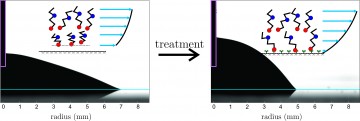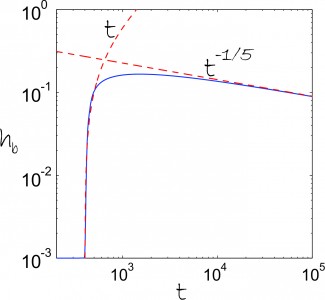Droplet Evaporation with Optical Coherent Tomography
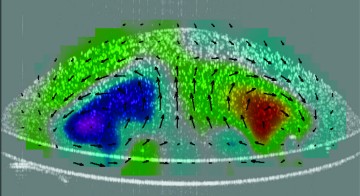
We are developing an optical technique based on the Optical Coherence Tomography (OCT), to visualize the flows in evaporating polymeric droplets. The project includes the development of the experimental technique, a nonlinear optical correction (pixel mapping) and eventually performing a classic PIV technique. We have done several tests on different solutions that form structure while evaporating. Results expect to appear this summer.
Controlling the Droplet Impact
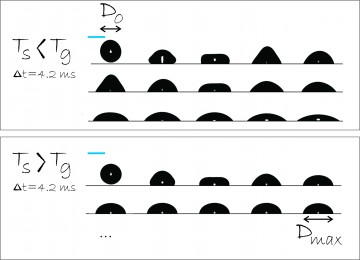
We have studied the impact of a “thermo-responsive” droplet that undergoes a gel formation above a given temperature. Performing the iso-thermal and non-iso-thermal experiments, we have shown one can control the dynamics and final shape of the droplets, changing the temperature of the substrate. The detail of the preliminary study can be found here. Currently we are studying the detail of the “solidification” at the contact line and also developing our model in the lubrication limit.
Slip of Viscoplastic Droplets
Droplets of complex fluids (pastes, gels, concentrated polymeric solutions, etc) undergo an apparent slip on “smooth” surfaces. We directly demonstrated this slip in experiments using a “high speed” confocal microscopy and also how to avoid it on glass, using a chemical treatment. If you are interested, read our recently published paper here.
Rheology of a thermo-responsive polymer
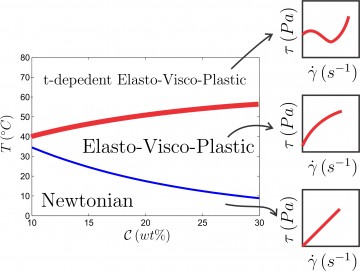
In our lab, we have used Pluronic in several applications like microfluidics switches, controlling droplet impact, and mixing. Doing a comprehensive set of rheometry, we have characterized the bulk properties of Pluronic F127 for the further investigations. We accurately measured the gel transition temperature, and showed that above this temperature, we have a yield stress fluid. At very high temperatures, the results became time-dependent and unrepeatable. Paper is submitted!
Theory of Viscoplastic Contact Line
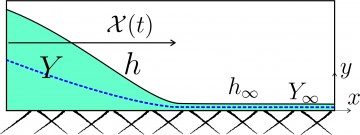
Using some Asymptotic methods, we have derived the solution fro the final shape of a spreading droplet, in a shallow limit. This required a detailed analysis of the condition at the contact line since the boundary conditions are not trivial. Analysis are carried out for the limits of complete wetting (presence of a pre-wetted film) and a Bingham rheology model. Results are going to be published together with the experiments (see below) this summer.
Experiments on Low Inertia Spreading of Yield Stress Droplets

We have extruded and impacted droplets of a yield stress material at different concentrations. The Reynolds number was small in all experiments. We covered the capillary and gravity dominated regimes and compared the results with the theory we developed, where a good agreement was observed. Several other phenomena, such as different impact scenarios, buckling of “tall” drops, and the effect of pre-wetted film is studied. Paper to be submitted this March.
Instabilities on a Droplet
Here is the result of a over 45-day simulation for much much less than a second physical time! Using a VOF method we have simulated the deformation of a droplet in an external gas stream to a very fine spatial scales. We could achieve this, employing an adaptive grid generation (Kudos to Stephane Popinet) . Results are published in this PoF paper.
Droplet Fragmentation
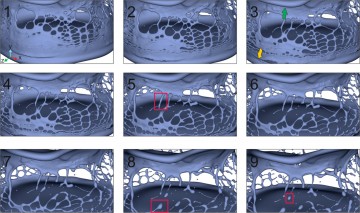
A falling droplet undergo a chaotic breakup, if the stresses induced on its surface are large enough. Using some expensive numerical simulations, we have resolved this problem from the large deformation to very small temporal and spatial changes. Check this paper for more details.
Electro-Hydro-Dynamics Mixers
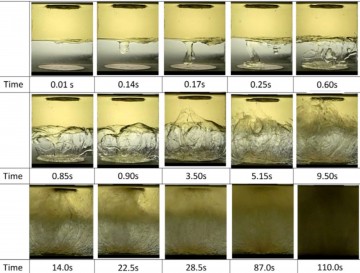
Through experiments, we have analysed the effect of high voltage electric fields on an initially stable stratified configuration of two miscible fluids. We have shown that the external stress at the liquid/liquid interface can results into mixing. The detail of the fluid dynamics, mixing etc is discussed here and here.
Bubbles and Drops under High Voltage Electric Field

We have studied the motion of falling drops and rising bubbles under the effect of an external high voltage electric filed. Deviation, touch, and rhythmic motion of droplets have been seen and studied in detail (see this and this papers for details). In case of Bubbles, we have shown the deformation and breakup of the bubbles (see this paper for details).
Exchange Flows with Large Density Ratio
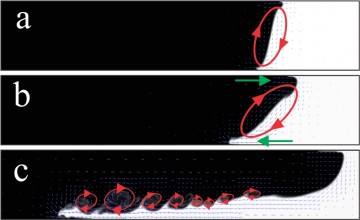
Using Numerical Simulation, we have studied the avalanche of Newtonian fluids at high Reynolds numbers. The simulations were carried for density ration of as high as 1000. The “tip-speed” was measured and compared with the available experimental results where a good agreement was observed. The Kelvin-Helmholtz instabilities were studied in detail and the effect of surface topography on hydrodynamics and mixing was studied in detail. Please contact me for a copy of the pre-print.
A Super-hydrophobic Fragmentation

We have studied the dynamics of impact and fragmentation of a round liquid jet on a super-hydrophobic surface. Different regimes depending on the Weber number and the impact angle were observed. A regime map was obtained for these regimes. The detail of interfacial instabilities was studied and the effect of viscosity on damping the instabilities was shown. Please contact me for a copy of the pre-print.
Cell Printing, A Numerical Study
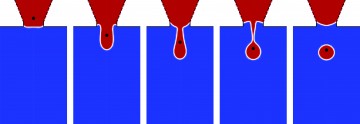
In a short project, we have conducted a set numerical analysis to model the injection of a cell, in a cell-printing process. The results, in addition to a simple analytical model explained the occasional failure of the current printing techniques due to the retraction of the meniscus. Please contact me for a copy of the pre-print.
Coalesence of Sessile Droplets
We have modeled the coalescence of two sessile droplets, using different techniques. First we modeled this in a “shallow” limit (picture above) where agreements were obtained between the model and the asymptotic analysis. Moreover, we have found the similarity solutions for this problem. Finally, the problem was studied, solving the Navier-Stokes equations by a finite-volume-VOF method. Please contact me for a copy of the pre-print.
Atomization (Secondary and Primary)
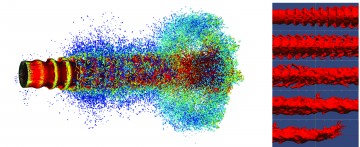
We have carried out a number of expensive simulations on (perturbed and un-perturbed) atomizing jets. Simulations were at low density ratio and moderate Reynolds numbers. The primary (hydrodynamic instabilities of the core) and the secondary (droplet distributions, droplet tracking etc) atomizations of the jets were studied in detail. The project was discontinued at some point but I will publish some of the results asap.
Droplets in Turbulent Flows
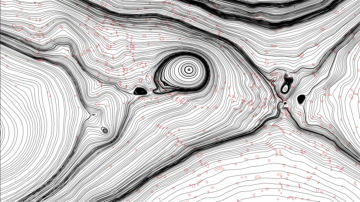
I have done some studies on breakup of droplet in an isotropic turbulent field and also have performed some works on chaotic flows caused by the fragmentation of the droplets (picture above). I have never published these but will publish a set of numerical results asap.
Numerical Methods

Beside using several commercial and open-source codes, I also have some experience working with some numerical methods such as meshless Differential Quadrature -based techniques and Eulerian-Lagrangian particle/droplet tracking techniques. Some of the studies can be found here and here.
Motion of Solid Particles
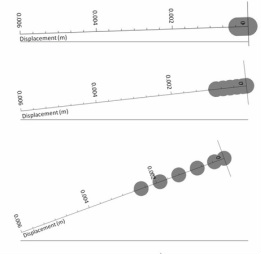
We have used some asymptotic methods to solve the equations governing the motion of a single solid particle that falls or rolls inside a viscous media. Some of the studies can be found here, here, and here.
